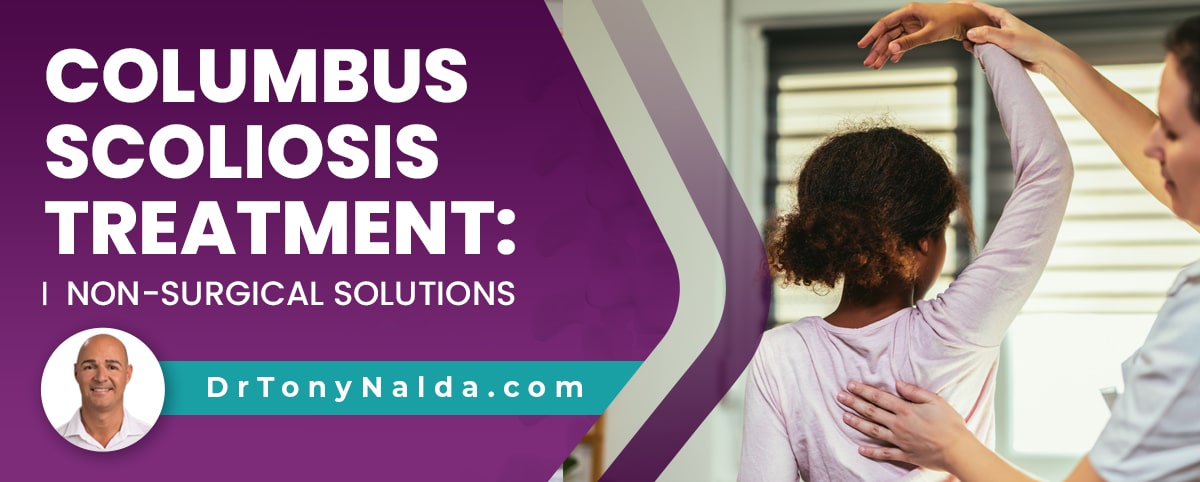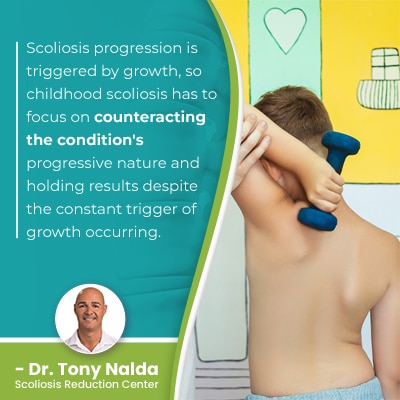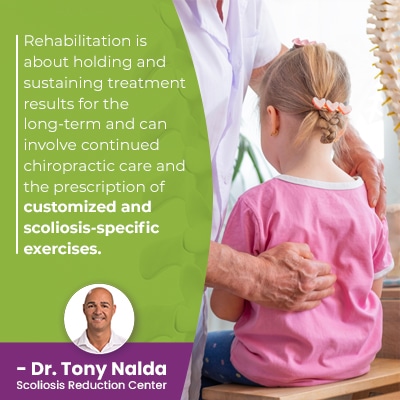Columbus Scoliosis Treatment: Non-Surgical Solutions

Scoliosis is a highly-prevalent condition that causes the spine to develop an unhealthy curvature. Some people have to travel to access the type of results Dr. Tony Nalda is associated with. Addressing scoliosis with non-surgical procedures has a number of benefits; continue reading to find out more.
When it comes to Columbus scoliosis treatment, a 2.5-hour flight to Orlando's Scoliosis Reduction Center® can mean accessing the non-surgical approach of Dr. Tony Nalda: renowned scoliosis chiropractor.
Scoliosis introduces uneven forces to the body, so let's start with how the body responds.
Table of Contents
Understanding Scoliosis: A Complex Condition
Scoliosis is a complex condition to treat for a number of reasons; as a progressive condition, its nature is to get worse over time, so when treatment is started is important, as well as the type of treatment started.
The Center's approach is proactive so is started as close to the time of diagnosis as possible, when conditions are at their mildest and simplest to treat; the more scoliosis progresses, the more overt its effects will be, and the more challenging it is to treat.
Progression makes the spine increasingly rigid and less responsive to treatment, and a rigid spine can make it difficult for some patients to perform key therapeutic exercises as part of treatment.
Scoliosis causes the spine to develop an unnatural sideways-bending and rotating spinal curve, and the condition doesn't just introduce uneven forces to the spine, but also its surrounding muscles, nerves, and the entire body.
 Scoliosis progression is triggered by growth, so childhood scoliosis has to focus on counteracting the condition's progressive nature and holding results despite the constant trigger of growth occurring.
Scoliosis progression is triggered by growth, so childhood scoliosis has to focus on counteracting the condition's progressive nature and holding results despite the constant trigger of growth occurring.
The most common form of scoliosis to affect all ages is idiopathic scoliosis, and the most prevalent type overall is adolescent idiopathic scoliosis diagnosed between 10 years of age and reaching skeletal maturity.
What patients need to understand is that although I can give no treatment guarantees, with early detection and intervention, there are fewer limits to what non-surgical scoliosis treatment options can achieve.
The Scoliosis Reduction Center® Approach
What's unique about the Center's approach is that it's proactive, innovative, and integrative; patients of the Center benefit from accessing multiple scoliosis-specific treatment disciplines under one roof.
A conservative approach is individualized to address the specifics of each patient's body and condition type.
One of the reasons Dr. Tony is worth traveling for are his training and certifications in multiple scoliosis-specific treatment modalities; adjusting the different disciplines accordingly based on how the spine is responding to growth and/or treatment means being able to fully customize treatment plans.
Conservative treatment is also known as chiropractic-centered and/or functional treatment because it works towards preserving as much of the spine's natural strength and function as possible.
The Center's results speak for themselves and prove that many cases of scoliosis don't require surgical treatment.
Conservative treatment combines the power of chiropractic care, physical therapy, corrective bracing, and rehabilitation so conditions can be impacted on every level.
As a CLEAR-certified scoliosis chiropractor, Dr. Tony prioritizes addressing the condition's underlying structural nature through chiropractic care.
Chiropractic Care
Chiropractic care has the goal of impacting the position of the curve's most-tilted vertebrae at its apex; manually adjusting the spine so it's alignment is improved means the vertebrae are stacked on top of one another in a straight and neutral alignment.
Chiropractic care can help achieve a curvature reduction, and this is impacting the structural abnormality within the spine itself.
Reducing the size of the unhealthy spinal curve means restoring its healthy curves, improving the spine's biomechanics, strength, and function.
But it's not just the spine that maintains its healthy curves and alignment; it's also the responsibility of the spine's surrounding muscles.
Physical Therapy and Scoliosis Exercises
Physical therapy and scoliosis exercises can help improve the spine's surrounding muscle balance and strength.
Strong core and back muscles means a spine that's receiving optimal support and stability, so muscle strengthening is a focus of treatment.
Physical therapy and scoliosis exercises can also address a muscular imbalance that's associated with scoliosis.
An unnatural spinal curve can pull its surrounding muscles in different directions, causing muscles on one side of the body to become stretched and sore from overuse while muscles on the opposite side can become weak from underuse.
Scoliosis-specific physical therapy and exercises can help improve the spine's surrounding muscle balance and strength to counteract the spine becoming increasingly unbalanced and unstable as progression occurs.
Corrective Bracing and Spinal Alignment
Corrective bracing is more effective on growing spines so is commonly used to treat childhood scoliosis, and it can help by pushing the spine into a straighter alignment.
The ScoliBrace is an ultra-corrective scoliosis brace that represents the culmination of what we've learned about scoliosis bracing and treatment efficacy over the years.
Corrective bracing can help by pushing the spine into a straighter alignment, and when combined with other forms of treatment with corrective potential, it can be a valuable facet of non-surgical scoliosis treatment.
Rehabilitation
Rehabilitation is about holding and sustaining treatment results for the long-term and can involve continued chiropractic care and the prescription of customized and scoliosis-specific exercises.
Lifestyle guidance is also an important part of rehabilitation, and this can include dietary and exercise recommendations.
So conservative non-surgical scoliosis treatment can offer impressive results, but with surgery as an option, why not opt for a surgical response?
Scoliosis Surgery Effects
 For Columbus oh residents, taking a 2.5-hour flight to access Orlando, Florida's Scoliosis Reduction Center® can be worth it, if it means helping patients avoid surgical intervention, and this is because scoliosis surgery is invasive and risky.
For Columbus oh residents, taking a 2.5-hour flight to access Orlando, Florida's Scoliosis Reduction Center® can be worth it, if it means helping patients avoid surgical intervention, and this is because scoliosis surgery is invasive and risky.
The truth is that many scoliosis cases don't require surgical treatment, and as there are so many potential risks, side effects, and complications associated with spinal fusion, the procedure should be considered carefully.
Spinal fusion involves fusing the curve's most-tilted vertebrae into one solid bone and attaching metal rods to the spine to hold it in place, but this is contrary to the spine's movement-based design and can make the spine more rigid and less flexible.
Spinal rigidity means a reduced range of motion, and this can also mean increased back pain and activity restrictions as a result.
Risks associated with the procedure itself can include nerve damage, infection, excessive blood loss, and adverse reaction to hardware used, and the procedure is permanent; a fused spine is fused for life, and if for some reason, it fails, the only recourse is more surgery.
A fused spine is also weaker and more vulnerable to injury, and there is a gap in the research on the long-term effects of living with a fused spine 20, 30, 40+ years in the future.
While hardware breaking isn't a common complication, rods cracking and/or a screw coming loose can occur, and if that happens, more surgery is needed, and the risks of each subsequent procedure increase.
Conclusion
When it comes to Columbus scoliosis treatment, the Scoliosis Reduction Center® can be an option with a 2.5-hour flight; once a patient of the Center, multiple treatment options are accessible under one roof.
Dr. Tony has built up a reputation for innovative non-surgical scoliosis solutions that include chiropractic care, corrective bracing, physical therapy, scoliosis exercises , and rehabilitation.
An unnatural spinal curvature can affect the body in a number of ways, and scoliosis is diagnosed through a physical examination and x ray results.
When it comes to treating scoliosis, as a progressive condition, being proactive is key, and related postural changes are most noticeable when bending forward.
To treat scoliosis effectively, its underlying cause has to be addressed, and in the majority of cases, we don't know the initial cause, but we know that atypical condition types have known causes that include neuromuscular scoliosis, degenerative scoliosis, and congenital scoliosis.
Part of diagnosing scoliosis involves comprehensive assessment so conditions are further classified based on key patient/condition variables: patient age, condition type, severity, and curvature location.
For those interested in a non-surgical treatment alternative, a conservative approach has a lot to offer, including a proactive response to a diagnosis by starting treatment immediately; a traditional surgical response is more reactive than proactive as it doesn't have a strategy for addressing scoliosis while mild.
Traditional treatment funnels patients towards a surgical response by doing little to prevent progression, but responding with surgery when/if progression into the severe classification occurs; modern conservative treatment offers patients a non-surgical alternative.
Dr. Tony Nalda
DOCTOR OF CHIROPRACTIC
After receiving an undergraduate degree in psychology and his Doctorate of Chiropractic from Life University, Dr. Nalda settled in Celebration, Florida and proceeded to build one of Central Florida’s most successful chiropractic clinics.
His experience with patients suffering from scoliosis, and the confusion and frustration they faced, led him to seek a specialty in scoliosis care. In 2006 he completed his Intensive Care Certification from CLEAR Institute, a leading scoliosis educational and certification center.
About Dr. Tony Nalda
 Ready to explore scoliosis treatment? Contact Us Now
Ready to explore scoliosis treatment? Contact Us Now





